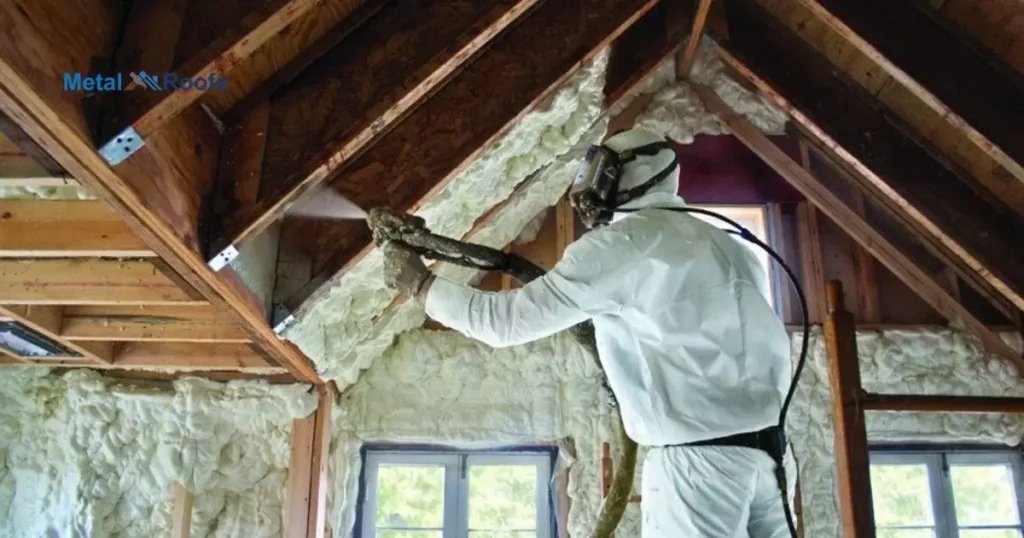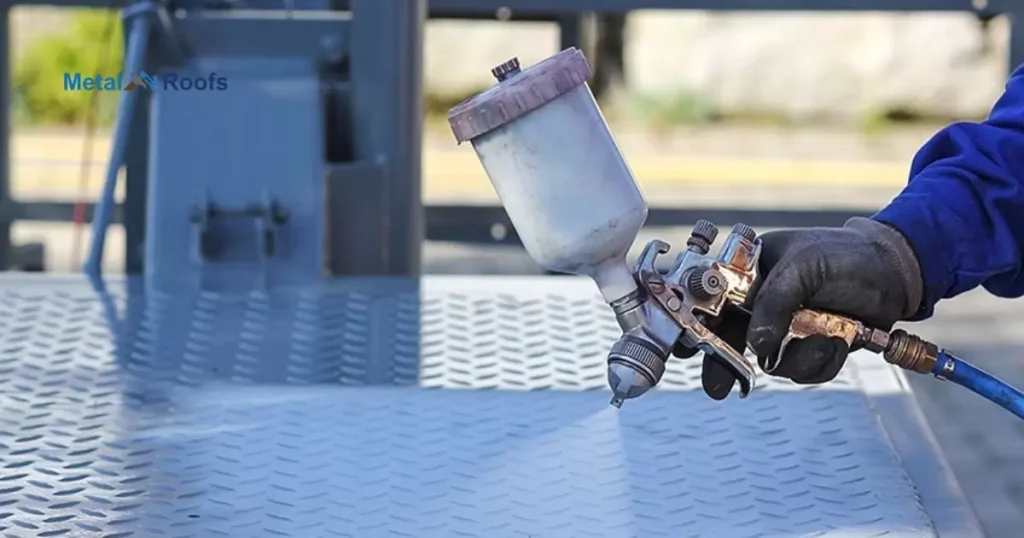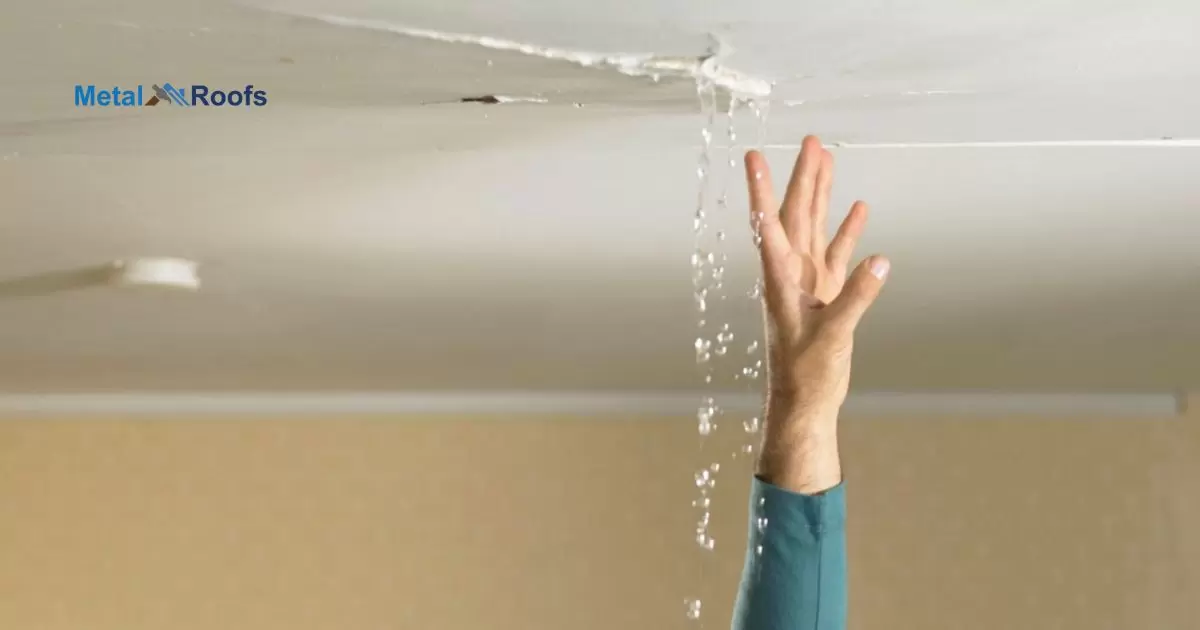Metal roofs can sweat when warm meets cold. Condensation forms underneath, causing rust. Proper ventilation and insulation prevent this. Roofers must install the roof right. Homeowners can avoid sweat issues.
Metal roofs can sweat terribly. This moisture causes rust and decay. The big question is – how to stop metal roof from sweating? Proper ventilation and insulation are key. Roofers must install vapor barriers too. Maintaining the roof also prevents sweat.
Sweating metal roofs can cause serious issues. Homeowners must address this problem. Proper installation with ventilation and insulation helps. Roofers should also use vapor barriers. Routine maintenance is crucial too. Taking the right steps stops metal roof from sweating.
Key Takeaways
- Ventilation is key
- Insulate the roof
- Install a vapor barrier
- Use reflective coatings
- Check for gaps and seals
- Control indoor humidity
Understanding Metal Roof Sweating
Metal roofs can sweat when warm, moist air inside a building meets the cooler metal surface. This collision creates condensation, leading to potential issues like rust and mold. To prevent this, ensure proper ventilation in the attic to balance temperatures and reduce condensation risk.
Insulate the roof and install a vapor barrier to maintain consistent temperatures and block moisture. Ensure proper support with a 2×4 span for a metal roof. Reflective coatings on the roof surface can also help minimize heat absorption and condensation formation.
Causes of Metal Roof Sweating
| Causes of Metal Roof Sweating | Solutions |
| Temperature Difference between Indoor and Outdoor | Ensure proper ventilation and insulation to minimize condensation. |
| Humidity Levels | Control indoor humidity through dehumidification methods such as exhaust fans or HVAC systems. |
| Lack of Insulation | Install adequate insulation to prevent temperature differentials and reduce condensation. |
| Poor Roof Ventilation | Improve roof ventilation to allow moisture to escape from the attic or roof space. |
Metal roof sweating occurs due to temperature and humidity differences. When warm, moist air from inside meets the cooler metal surface, condensation forms. Lack of ventilation exacerbates the issue by trapping moisture. Insufficient insulation allows heat transfer, causing condensation.
Damaged sealing or flashing lets moisture seep in, increasing sweating. Controlling indoor humidity and improving ventilation can mitigate this problem. Reflective coatings and vapor barriers also help in prevention. These measures maintain a balanced environment, reducing metal roof sweating.
Preventing Metal Roof Sweating

To prevent metal roof sweating, start with good ventilation. Soffit vents and ridge vents help air circulate. This keeps temperatures consistent inside and out. Next, add insulation between the roof and inside. Insulation maintains even temperatures, reducing condensation risk.
Then, install a vapor barrier on the warm side of insulation. This stops moisture from entering and condensing. Use reflective coatings on the roof’s surface. This reduces heat absorption, minimizing temperature differences.
Proper Insulation for Metal Roofs
Insulating metal roofs is vital to prevent condensation. Proper insulation keeps temperatures stable, reducing the risk of moisture buildup. Choose insulation with a high R-value for better performance. Reflective coatings can also help by minimizing heat absorption.
Insulation installation should include a vapor barrier to stop moisture infiltration. Ventilation is crucial for maintaining balanced humidity levels. Control indoor humidity with exhaust fans and dehumidifiers. Ensure sealing and flashing are intact to prevent water infiltration.
Ventilation Strategies for Metal Roofs
Improving ventilation is crucial for metal roofs to prevent condensation. Soffit and ridge vents help balance temperature and humidity levels. Insulating the roof also maintains consistent temperatures, reducing condensation risk. Proper sealing of gaps and joints prevents water infiltration, enhancing effectiveness.
Controlling indoor humidity through exhaust fans and dehumidifiers further minimizes condensation. Reflective coatings on the roof surface reduce heat absorption, lowering the temperature difference. Considering insulation methods like warm roof systems can effectively prevent condensation.
Roof Pitch and Metal Roof Sweating
Metal roof sweating can be influenced by the pitch of your roof. A steeper pitch allows for better water runoff, reducing the risk of condensation. Ensure your roof has proper ventilation and insulation to prevent moisture buildup.
Reflective coatings can also help in minimizing heat absorption, decreasing the temperature difference between inside and outside. Proper sealing of seams and joints is crucial to prevent water infiltration. Controlling indoor humidity levels can further mitigate the risk of metal roof sweating.
Types of Insulation for Metal Roofs

Insulating a metal roof is crucial for maintaining energy efficiency and comfort within a building. There are several types of insulation commonly used for metal roofs:
Fiberglass Insulation: Fiberglass batts or rolls are commonly used in metal roof applications. They are relatively inexpensive and offer good thermal performance.
Spray Foam Insulation: Spray foam insulation, either open-cell or closed-cell, can be sprayed directly onto the underside of the metal roof deck. It adheres well to irregular surfaces and provides an effective air barrier, minimizing air leakage and enhancing energy efficiency.
Reflective Insulation: Reflective insulation, often made of aluminum foil laminated to a substrate such as polyethylene bubbles or foam, is designed to reflect radiant heat away from the building.
Rigid Board Insulation: Rigid foam boards, such as expanded polystyrene (EPS), extruded polystyrene (XPS), or polyisocyanurate (polyiso), can be installed on the underside of the metal roof deck.
Mineral Wool Insulation: Mineral wool, also known as rock wool or slag wool, is a dense insulation material made from natural or synthetic minerals. It offers excellent fire resistance and sound absorption properties in addition to thermal insulation.
When selecting insulation for a metal roof, consider factors such as the climate, desired R-value, budget, and installation method. It’s also essential to ensure proper ventilation to prevent moisture buildup and maintain the longevity of the roof and insulation system.
Air Transfer Prevention in Metal Roofs
Preventing air transfer in metal roofs is crucial to avoid condensation issues. Proper ventilation is key ensure your attic has enough vents. Insulating the roof keeps temperatures stable; use high R-value materials. Reflective coatings on the roof reduce heat absorption, limiting condensation risk.
Checking for gaps and sealing them tight keeps moisture out. Control indoor humidity levels; use exhaust fans and dehumidifiers if needed. Consider insulation methods carefully to prevent future problems. With these steps, you can keep your metal roof dry and sturdy.
Dripstop Metal Roofing
Dripstop Metal Roofing helps prevent condensation on metal roofs. It consists of a special membrane that absorbs and traps moisture, preventing it from dripping onto the building’s interior. This membrane is installed directly onto the underside of the metal roof panels, providing a barrier against condensation.
With Dripstop Metal Roofing, you can avoid issues like rust, mold, and water damage caused by roof sweating. It’s an effective solution for maintaining a dry and comfortable indoor environment while protecting your building structure.
Anti Condensation Spray For Metal

To tackle metal roof sweating, consider anti-condensation spray. This solution helps by creating a protective layer on the metal surface. It reduces the formation of condensation, preventing potential issues like rust and mold.
Application is straightforward, requiring only spraying onto the metal roof’s surface. The spray forms a barrier that inhibits moisture buildup, keeping your roof dry and protected. It’s an easy and effective way to maintain the integrity of your metal roof and prolong its lifespan.
Frequently Asked Questions
How do you stop condensation on a metal roof?
Prevent metal roof condensation improve ventilation, insulate, use reflective coatings, seal gaps, control indoor humidity, consider insulation methods.
What do you put under a metal roof to keep it from sweating?
To prevent metal roof sweating, improve ventilation, insulate, use reflective coatings, seal gaps, control indoor humidity, and consider insulation methods.
Should you put a moisture barrier under metal roof?
A moisture barrier under a metal roof is essential. It prevents condensation and protects against rust and mold.
Conclusion
Metal roofs can sweat badly. This leads to rust and decay. Proper ventilation and insulation stop the sweat. Roofers must use vapor barriers during installation.
Maintaining the roof also prevents sweat problems. Homeowners must take the right steps. Addressing the issue is crucial for the roof. With the right approach, metal roof sweating stops.











